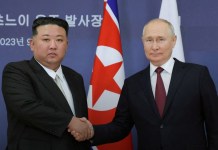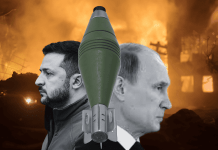Rattled by Turkey’s purchase of 20 Eurofighter Typhoon fighter jets, Greece is reportedly considering expanding its Rafale fleet with the more advanced F4 and F5 variants.
After a protracted struggle to upgrade its outdated Air Force, Turkey signed a $10.66 billion deal for 20 Eurofighter Typhoons on October 27, with an option for buying more later. T
he deal includes a comprehensive weapons package, including the lethal MBDA Meteor air-to-air missile and Brimstone ground attack missile, Reuters reported, citing informed sources. The first of these cutting-edge European aircraft is expected to arrive in Turkey by 2030.
In addition to brand-new fighters, Turkey is in talks to procure 24 Eurofighter Typhoons Tranche 3A from Qatar and Oman. These older jets will serve as a stopgap solution until the more advanced variant of the Eurofighter Typhoon arrives.
Concerned over Turkey amassing a 44-fighter Typhoon fleet, its arch-rival Greece is now mulling the option of buying additional Rafale fighters from France in the latest F4 or future F5 configuration, Greek publication Ekathimerini reported, citing unidentified defense sources.
Greece and Turkey have a long-standing rivalry rooted in historical conflicts and ongoing territorial disputes, primarily in the Aegean Sea.

The report exuded confidence that Turkey’s acquisition of 20 Eurofighters would not alter the balance in the Aegean region, highlighting that the Hellenic Air Force (HAF) maintains technological and operational dominance with its current F-16 Viper and Rafale fleets and the planned acquisition of stealthy F-35.
However, in the same breath, it added that Athens has been closely watching Turkey’s acquisition of the 4.5th-generation multi-role fighter jet, equipped with Beyond Visual Range (BVR) capabilities such as Meteor missiles.
The Greek publication speculated that Turkey could acquire the latest Tranche 5 variant of the Eurofighter, sharing development costs with Germany, which has already placed an order for the model. It underscored that the Tranche 5 is expected to feature a more powerful radar, enhanced electronic warfare (EW) systems, and improved sensor and weapons integration compared to the Rafale F3R operated by the Hellenic Air Force (HAF).
“Although the variant and radar type have not been confirmed, the late delivery timeline raises expectations that these aircraft will be Tranche 5 models equipped with the ECRS Mk2 AESA radar,” wrote TurDef.
It is pertinent to note that both the Eurofighter Typhoon and the Rafale are twin-engine, delta-canard, 4.5-gen multirole fighters with superb agility, AESA radars, and Meteor BVR missiles. They were born from the same 1980s European project—France walked out to build Rafale, and the rest of the members created Typhoon.
Currently, the Rafale F4 is in full-rate production, F5 is under contract for production in the 2030s, and Tranche 5 Typhoon is just entering production.
The French F4 is an evolution of the Rafale F3R and features superior capabilities, including the Thales software-defined radio, satellite communications, and other improvements to the RBE2 AESA radar, Talios targeting pod, front-sector optronics system, and helmet-mounted display capabilities. It also features a new digital jammer for the SPECTRA self-defense/electronic warfare suite.
It is armed with MBDA’s MICA NG (Next-Generation) air-to-air missile and the 1,000-kilogram variant of Safran’s AASM “Hammer” precision-guided munition. The 1,000-kilogram variant provides the Rafale with an enhanced strike capability. The aircraft can now carry three of these bombs.
A new integrated propulsion system in the bombs extends the standoff range. Moreover, the F4 variant also has a laser-homing AASM version, especially suited to destroying moving targets at distances of several kilometers with high precision. It is also possible to control the munition flight time, laser illumination, and in-flight weapon settings for terminal-laser-guided AASMs.
The Rafale F5 variant, also called the ‘Super Rafale,’ is currently under development and is regarded as the most advanced variant of the aircraft conceptualized to date.
Dassault Aviation CEO Eric Trappier said earlier this year that the “F5 variant of Rafale will have more powerful engines, improved survivability and data links, and will be accompanied by an unmanned combat air vehicle (UCAV) weighing more than 10t.”
The Rafale F5 is being developed to act as a stopgap until the French Armed and Space Forces build the next-generation fighter. It is often considered a sensor, data fusion, and processing tactical flying command post. This is similar to the capabilities of the F-35, which features pioneering, nearly unparalleled sensor fusion technology.
The Ministry of Armed Forces tabled an amendment in May 2023 to provide more information about the Rafale program’s upcoming efforts.
It stated that two new capabilities were to be introduced to the Rafale F5: a loyal-wingman drone (as discussed above) and suppression of enemy air defenses (SEAD). It was admitted that it was now necessary to equip the Rafale in its future versions with the ability to suppress enemy anti-aircraft defenses.
Meanwhile, the new Eurofighter Tranche 5 (ordered only by Germany so far) will be outfitted with the latest sensors.
The new electronic E-Scan radar, sometimes called the European Common Radar System (ECRS) Mk 1 AESA (Active Electronically Scanned Array) radar, is notably noted among these. Simultaneously, Airbus claims it will incorporate the Saab Arexis sensor suite into both new and existing aircraft to add electronic warfare (EW) capabilities.
Additionally, a better cockpit interface and increased Radio Frequency Interoperability (RFIO) are reportedly included in the package, thereby increasing lethality and survivability.
Although it has been revealed that a Large Area Display is being developed for the Typhoon, it is currently unclear whether this will be part of the new, enhanced cockpit interface.
As of now, it is not clear whether Turkey will opt for Tranche 5 of the Eurofighter or whether Greece will buy a more advanced variant of the Rafale.
Cat & Mouse Game Between Greece And Turkey
Greece moved at lightning speed to upgrade its air power and establish a qualitative military edge over the Aegean Sea after Turkey was kicked out of the F-35 Joint Strike Fighter (JSF) program. Its defense industry was sanctioned under CAATSA (Countering America’s Adversaries Through Sanctions Act) by the US for buying the Russian S-400 air defense system.
Greece signed a deal in January 2021 to purchase 12 used and 6 new Rafale fighters to upgrade its air power and deter Turkey. The deal was later expanded to include 6 additional Rafales, bringing the total to 24 of these 4.5th-generation fighters.
The Hellenic Air Force officially completed the acquisition of 24 Rafale fighter jets in January 2025, a milestone hailed as a watershed for the country. At the time, the Greek media proudly declared that the HAF had achieved complete air superiority over Turkey, which was still operating older Block 30-50 F-16 fighter jets.
The milestone was not only attributed to the Rafale but also to the Meteor missile, which will be integrated with the French fighter jet. The missile, renowned for its ability to engage high-speed targets at distances of up to 200 kilometers and speeds exceeding Mach 4, is superior to all the air-to-air missiles in the Turkish inventory.
It was for this reason that Turkey, staring at an increasingly outdated fleet, criticized Greece’s Rafale procurement, arguing that it undermined regional peace and stability.
In 2023, while Turkey was still struggling to secure the US’s provision of the latest Block 70/72 F-16 Viper jets, a Turkish Air Force Commander, General Abidin Ünal, warned that Greece would have a decisive edge in air superiority if Turkey failed to modernise its fleet.
On its part, Greece continued upgrading its F-16 Block 52+ aircraft to the F-16V Viper Block 72 configuration under a 2018 contract with Lockheed. All 84 F-16 fighters will be upgraded by 2027.
With the capability gap with Greece widening, Turkey advanced work on its own fifth-generation fighter (KAAN), and it decided to acquire a 4+-generation aircraft. In November 2023, Turkey’s defense minister, Yasar Gular, announced that the country was in talks with Spain and the United Kingdom to buy Eurofighter Typhoons.
In February 2024, Turkey secured a major win when the US approved the sale of F-16 Block 70/72 fighter jets in exchange for Sweden’s ratification of its NATO membership.
However, Greece soon pulled an ace in July 2024, announcing it would acquire F-35 fighter jets through the US Foreign Military Sales (FMS) program. It is set to acquire 20 jets, with the option to order 20 more in the future.
Meanwhile, Turkey’s quest for the Eurofighter hit a massive roadblock when Germany refused to allow the export of the fighter jets to Turkey, citing Ankara’s human rights violations. The veto was finally lifted in July 2025.

Turkey has also been pushing for its return to the F-35 program. Earlier this year, Erdogan told reporters that he was optimistic about making headway in persuading the White House to lift the restrictions preventing Turkey from acquiring F-35 Fighter Jets.
Additionally, Turkey is now set to resume high-level negotiations with Lockheed Martin to end a protracted pricing impasse about its $23 billion F-16 acquisition program. Defense officials from both sides will meet in the upcoming weeks to resolve these issues.
It can be said that Turkey is upgrading its F-16 fleet to counter Greek F-16s, pushing to purchase F-35s to counter Greek F-35s, and acquiring the Eurofighter Typhoon to rival the Greek Rafale.
Meanwhile, Greece is making every effort to maintain its qualitative edge over Turkey. In addition to upgrading its own air force, it has been lobbying with allies to prevent Turkey from obtaining lethal munitions.
In January this year, Greek Defense Minister Nikos Dendias told Laurence Auer that the French ambassador to Greece said France opposes the potential sale of Meteor missiles to Turkey by a consortium that also includes France.
“I expressed to the French ambassador the strong opposition of Greece to such a possibility, which is not in line with the excellent strategic relations between the two countries,” Greek Defense Minister Nikos Dendias told Laurence Auer.
- Contact the author at sakshi.tiwari13 (at) outlook.com
- Follow EurAsian Times on Google News




